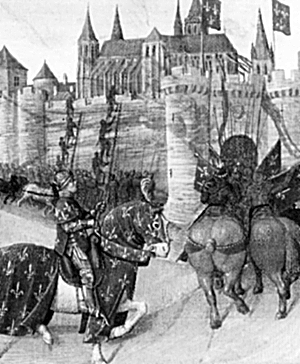
GALINIE, HENRI (ed.). Tours antique et médiéval. Lieux de vie, temps de la ville: 40 ans d'archéologie urbaine (Revue Archéologique du Centre de la France Supplément 30, numéro spécial de la collection Recherches sur Tours). 440 pages, c. 300 colour & b&w illustrations, CD-ROM. 2007. Tours: FERACF; 978-2-913272-15-6 paperback €39 + €6 p&p.

Review by Jason Wood
Centre for Tourism and Cultural Change, Leeds Metropolitan University, UK
(Email: jwhcs@yahoo.co.uk)
It is now over thirty years since this reviewer first pitched up in Tours after replying to an advert in the Council for British Archaeology's Calendar of Excavations. The Laboratoire d'Archéologie Urbaine de Tours was founded in 1973 and run by Henri Galinié and his assistant Bernard Randoin. Both had excavated at Wolvesey Palace in Winchester for Martin Biddle and had set up what amounted to the first urban unit in France, introducing 'La méthode Winchester' to the French archaeological lexicon. My first job back in 1978 was to erase the word 'Winchester' from all the pre-printed drawing sheets (which Galinié had acquired from Biddle) and to substitute 'Tours'. My second was to fabricate wooden planning frames out of bits of eighteenth-century windows from the largely disused Château building where the Laboratoire had its offices. It was only then that I was allowed to dig anything, spending two months down a huge medieval cesspit, directed by Galinié from the Château's first floor window. Later that season I got to run my first excavation - a deep, complicated sequence of Roman and medieval defensive ditches immediately outside the Roman amphitheatre incorporated into the later city walls.
At first glance this sumptuously illustrated new book, which accompanied a major exhibition in the now refurbished Château, was, for me, the archaeological equivalent of seeing pictures of oneself in a pram - memorable names and places, familiar photographs and drawings. But on closer inspection there is much that is new here, or more readily accessible, as the book is not an exhibition catalogue but rather an extremely useful and timely compendium, bringing together for the first time the results of forty years of excavations and architectural studies, which had only previously been available in difficult-to-source local journals or unpublished reports.
Tours, and Galinié, are synonymous with the birth of modern urban archaeology in France. It is no coincidence that Tours was chosen to host the first Colloque international d'archéologie urbaine in 1980 or that Galinié became the first director of the Centre National d'Archéologie Urbaine created four years later in Tours. Sporadic yet important evidence was recorded in the nineteenth and early twentieth centuries, but from the late 1960s Tours was the focus of continuous fieldwork by different research units, initially the Laboratoire d'Archéologie Urbaine de Tours and later the state-run archaeological services, the Association pour les Fouilles Archéologiques Nationales (AFAN) and now the Institut National des Recherches Archéologiques Préventives (INRAP).
The present book represents the combined effort of some seventy archaeologists, architects and historians brought together by Galinié. Chapter 1 provides a short historical background setting out the five principal phases of the city's development during the Roman and medieval periods. The bulk of the evidence is presented in Chapter 2. This opens with a site-by-site description of over twenty different excavations spanning the years 1968 to 2003. The most significant sites include the Château (transition from early to late Roman city, late Roman walls and residence of the Counts of Anjou); the so-called 'Archives' site (Roman and medieval ditches); St Martin's Basilica (cemetery, monastery and canons' houses); Hôtel de Police Sud and Place François Sicard (Roman houses); Lycée Descartes (Roman baths); Rue Nationale (Roman temple); and Parking Anatole-France (medieval defences and river frontage). The second part of chapter 2 presents the results of architectural studies, with new or revised interpretations being offered on Roman bridges, the amphitheatre, the late Roman walls, the tenth-century walls enclosing St Martins's and medieval houses and churches. Chapter 2 closes with a reconsideration of various historical documentary sources both written and pictorial. Chapter 3 provides a synthesis and conclusion.
Assembling and presenting such a wealth of information from so many individuals, from across a range of different disciplines, is no easy task and Galinié deserves much credit for the initial inspiration and for bringing the book to fruition. On the whole the most valuable sections are those setting out the fieldwork evidence, although inevitably there is a fair amount of repetition here given the way chapter 2 is divided between the results from excavations, architectural studies and documentary research. The promised synthesis in chapter 3 is where one might have expected this intersection of evidence to have been developed and for overlapping themes to have emerged. Unfortunately, the attempt at synthesis is somewhat muddled by the introduction of an assortment of various themes which, although set out in chronological order, are difficult to follow as a good deal of the material covers new, unrelated (though admittedly interesting) topics. Surprisingly, the conclusion is presented as a table rather than discursive continuous text while the references and bibliography are relegated to a CD.
Overall, however, the book is a great success and a fitting tribute to the work of Galinié and his colleagues and to the thousands of diggers who turned up year after year and to whom the book is dedicated.
